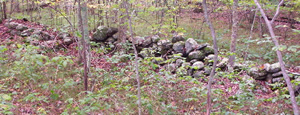Very few of these (especially the oddest-shaped constructions) may be pre-European in age.
Regardless of their original origin, all have since become ruins.  Thorson Photo: Abandoned wall in UCONN Forest, Storrs, CT.
These are the woodland walls where, if a stone falls down, it's usually left where it fell. They are not taken care of. This makes them no more, and no less, wild than the creatures that live on, below, within, and near them. The fact that they are tumbled doesn't diminish their importance, because they have become part of local ecologic and watershed processes. For clues, look for walls that are:
Surrounded by trees
Tumbled and damaged, especially along the top.
Occupy large land tracts.
Covered by lichens and moss.
Seldom made of quarried ston(e)."
Acessed from WWW, Nov.13, 2006 from:
http://www.stonewall.uconn.edu/Conserve3types.htm
Thorson Photo: Abandoned wall in UCONN Forest, Storrs, CT.
These are the woodland walls where, if a stone falls down, it's usually left where it fell. They are not taken care of. This makes them no more, and no less, wild than the creatures that live on, below, within, and near them. The fact that they are tumbled doesn't diminish their importance, because they have become part of local ecologic and watershed processes. For clues, look for walls that are:
Surrounded by trees
Tumbled and damaged, especially along the top.
Occupy large land tracts.
Covered by lichens and moss.
Seldom made of quarried ston(e)."
Acessed from WWW, Nov.13, 2006 from:
http://www.stonewall.uconn.edu/Conserve3types.htm
 Thorson Photo: Abandoned wall in UCONN Forest, Storrs, CT.
These are the woodland walls where, if a stone falls down, it's usually left where it fell. They are not taken care of. This makes them no more, and no less, wild than the creatures that live on, below, within, and near them. The fact that they are tumbled doesn't diminish their importance, because they have become part of local ecologic and watershed processes. For clues, look for walls that are:
Surrounded by trees
Tumbled and damaged, especially along the top.
Occupy large land tracts.
Covered by lichens and moss.
Seldom made of quarried ston(e)."
Acessed from WWW, Nov.13, 2006 from:
http://www.stonewall.uconn.edu/Conserve3types.htm
Thorson Photo: Abandoned wall in UCONN Forest, Storrs, CT.
These are the woodland walls where, if a stone falls down, it's usually left where it fell. They are not taken care of. This makes them no more, and no less, wild than the creatures that live on, below, within, and near them. The fact that they are tumbled doesn't diminish their importance, because they have become part of local ecologic and watershed processes. For clues, look for walls that are:
Surrounded by trees
Tumbled and damaged, especially along the top.
Occupy large land tracts.
Covered by lichens and moss.
Seldom made of quarried ston(e)."
Acessed from WWW, Nov.13, 2006 from:
http://www.stonewall.uconn.edu/Conserve3types.htm
No comments:
Post a Comment